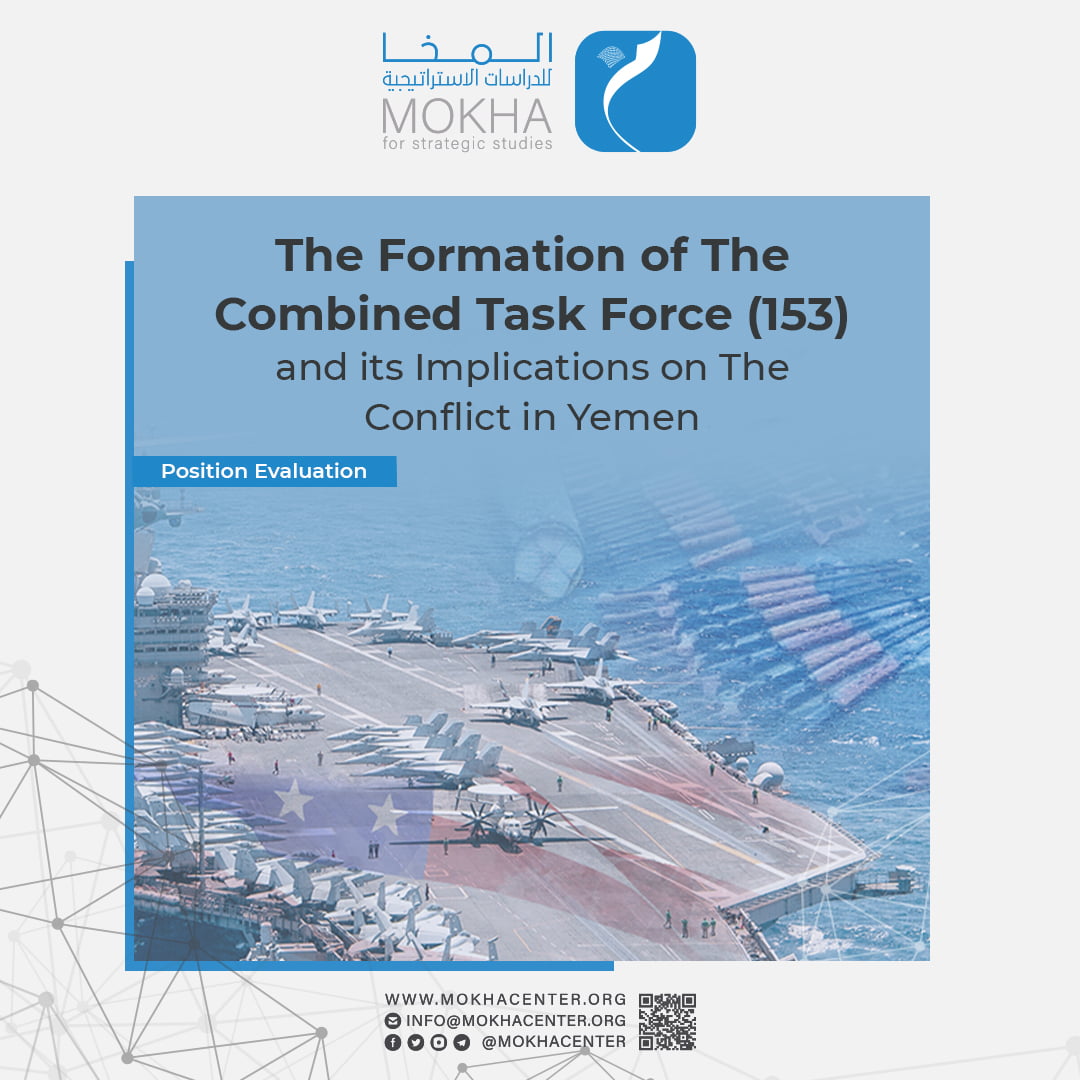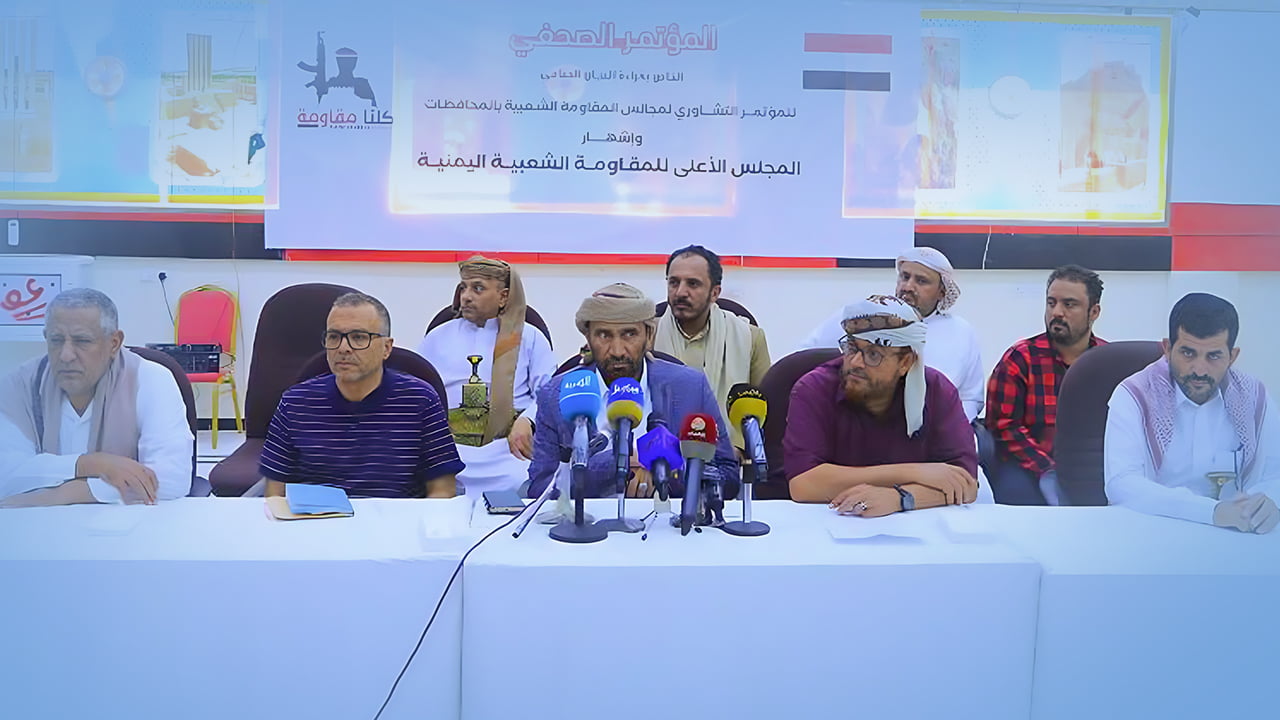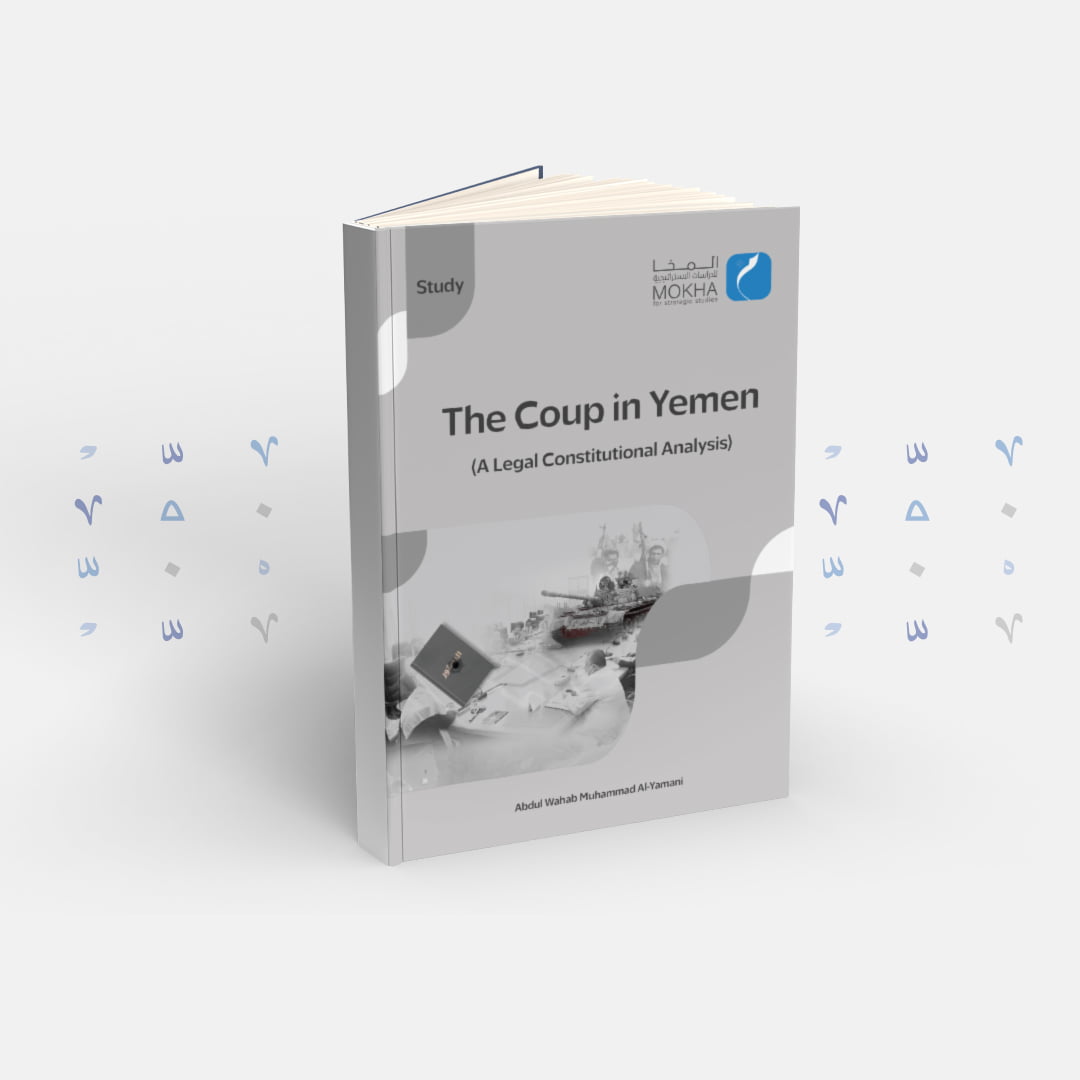The Formation of The Combined Task Force (153) and its Implications on The Conflict in Yemen

| Getting your Trinity Audio player ready... |
Introduction:
In April 2022, The U.S. Fifth Fleet (which is stationed on the territorial waters in the Arabian Gulf, the Arabian Sea and the Red Sea) launched a joint naval force, called Combined Task Force 153, in partnership with the allied countries and several countries in the region. The combined forces conduct military activities that deal with threats to maritime security and international navigation in the Gulf of Aden, Bab al-Mandab and the Red Sea. Most likely, the activities of this force will have an impact on the conflict in Yemen, which requires identifying its nature (i.e., the Combined Task Force), its tasks and its possible effects on the ongoing war in Yemen.
General information about the U.S. Navy
The U.S. Navy — managed by the U.S. Central Naval Administration — is the largest and most powerful navy in the world. It maintains a military presence and owns several military bases in various regions, like Japan (which is the largest naval base in the world), Italy, Greece, Spain, Bahrain, Qatar, Guantanamo Bay and Cuba. It also owns several naval fleets spread in international waters in locations of strategic importance in the world, as shown in the following table:
| Fleet | Year establishment | Presence and activities | Area of operation |
| Second | Established in 1943, it was suspended in 2011 and re-established in 2018 to confront Russia. | Norfolk, Virginia. | North Atlantic and East Coast of the United States. |
| Third | From 1943 until now. | San Diego, California. | East and Northeast Pacific Ocean, and the U.S. West Coast as far north of Alaska. |
| Forth | 1943-1950, and was re-established in 2008. | Mayport, Florida. | The South Atlantic, the Caribbean and all that surrounds South and Central America. |
| Fifth | Established in 1944; it was deactivated in 1947. It remained inactive until 1995. | Manama, Bahrain | The Arabian Gulf and parts of the Indian Ocean, the Arabian Sea and the Red Sea. |
| Sixth | From 1946 to now. | Naples, Italy. | Europe, the Mediterranean and Africa. |
| Seventh | From 1943 to now. | Yokosuka, Japan. | Western and Northern Pacific, Indian Ocean, Southeast and East Asia. |
| Tenth | 1943-1947, then re-established in 2010. | Fort Meade, Maryland, U.S. | Responsible for the Cyber Command of the U.S. Navy’s fleets, which, in turn, is responsible for naval cyber warfare (network warfare) programs. |
The following map outlines the areas of the U.S. Navy:
The Fifth Fleet area of operations
The Fifth Fleet was established in 1944, then deactivated in 1949, after participating in World War II, and was re-activated again after the 2nd Gulf War, in 1995. It is considered to be a military naval force that protects strategic American interests in the Gulf region, through naval forces or air support. The Fifth Fleet is responsible for securing oil supplies from the Gulf region to global markets, supervising U.S. military operations in the region, including war operations in Afghanistan and Iraq, and dealing with maritime piracy, especially off the Somali coasts in the Gulf of Aden and the Red Sea. It is also responsible for monitoring Iran’s military and naval activities, as well as participating in the so-called “war on terror” in Yemen, Somalia and the Horn of Africa.
The operations of this fleet extend from the Arabian Gulf to the Arabian Sea, parts of the Indian Ocean and even the northern end of the Red Sea. Within its area of operation, there are three important waterways: the Strait of Hormuz, the Bab al-Mandab Strait and the Suez Canal. To implement its strategic operations, the fleet owns a large naval base in Manama, the capital of Bahrain, which holds manpower (about 3,500 soldiers), and military equipment that includes: an aircraft carrier, several attack submarines, naval destroyers, more than 70 fighters and about 17 tactical combat boats, carrying bombers, drones, refueling planes, etc.1
Partnerships and alliances:
In addition to the military forces and troop strength of the fleet, it works to achieve its goals by establishing and leading joint military forces with international and regional countries. Currently, the Fifth Fleet leads two major military alliances in the region:
- The International Maritime Security Construct: It maintains the freedom of navigation and the free flow of trade for legitimate mariners in the international waters of the Middle East region. The current members of IMSC are the Gulf states (except Oman), Britain, Australia, Albania and, recently, Romania, as well as the United States.
- Combined Maritime Forces: It is the largest maritime partnership in the world, currently consisting of 34 countries after the joining of Egypt last year. Within the framework of this partnership, several combined naval military forces have been established, which carry out specialized tasks in the maritime waters of the region:
- Combined Task Force 150 (CTF): It specializes in patrolling the Arabian Sea and the Gulf of Oman.
- CTF 151 (Counter-piracy): It specializes in confronting Somali piracy on merchant ships.
- CTF 152 (Gulf Maritime Security): Formed in 2004, it is concerned with maritime security in the Arabian Gulf.
- Task Force 59: Established by the U.S. Naval Forces Central Command (NAVCENT) in September 2021 to rapidly integrate unmanned systems and artificial intelligence with maritime operations in the Fifth Fleet area of operations in the Arabian Gulf.2 The Fifth Fleet carries out several maritime exercises with the countries of the region, the last of which was organized by the U.S. Navy in the Red Sea, in February 2022, in which 60 countries participated, and lasted for 18 days.
Combined Task Force 153 (CTF 153): Formation and mission
Established by the Fifth Fleet in 2022, it is responsible for securing navigations in the Red Sea, in cooperation with the joint naval forces (regional countries and allied countries). The primary mission of this force is to help ensure maritime security and navigation stability in the Red Sea, through Bab al-Mandab and the Gulf of Aden.
The CTF 153 consists of two to eight ships, as well as an amphibious command ship, where new naval vessels are expected to be added by the participating regional countries. It aims to prevent the smuggling of coal, narcotics, weapon, and people in the waterways in its area of operations,3 which starts from the Strait of Hormuz, the Arabian Sea, parts of the Indian Ocean and the Gulf of Aden, all the way to the Suez Canal at the northern end of the Red Sea.
As mentioned above, this force focuses on the Red Sea, Bab al-Mandab and the Gulf of Aden, to achieve the following declared goals:4
- Ensuring the free flow of international trade.
- Preventing hostile activities.
- Enhancing cooperation between regional maritime partners to ensure security in the Red Sea, Bab al-Mandab Strait and the Gulf of Aden.
- Exploring seas and coasts, especially after the incorporation of drones with artificial intelligence, easing the way to explore farther distances in the region.
The Context
The formation of this force came in light of several factors related to the region and the world, including:
- The great importance of the region, as it’s considered to be a vital point for global trade according to Brad Cooper, commander of the Fifth Fleet, and any conflict in the region would have a global negative impact.
- The expansion of the military operations areas supervised by the Fifth Fleet, and its inability to carry out maritime patrols on its own, led to the need to form a special force in the region of the Red Sea and the Gulf of Aden.
- The Houthi attacks launched on commercial ships represented a high threat to the security of international navigation. While the media in the coalition countries suggest that the threats posed by the Houthis are the main reason for the formation of this force, the commander of the U.S. Navy’s Fifth Fleet in the Middle East disagreed during a press conference in April 2022.
- The establishment of this force indicates a slight shift in U.S. policy toward the region, which is based on not withdrawing from it or at least postponing it, which resulted from the Russian war on Ukraine, the energy crisis and the high level of inflation, which affected global situations and policies.
- The need of the regional countries, especially Washington’s allies, for such a force, is due to the failure of the proposed security solutions for the navigation in the Red Sea and the Gulf of Aden. The establishment of a new organization for the countries bordering the Red Sea, called the “the Council of Arab and African States Bordering the Red Sea and the Gulf of Aden”, in which the foreign ministers of Saudi Arabia, Egypt, Sudan, Jordan, Eritrea, Yemen, Djibouti and Somalia signed its charter in Riyadh on January 6, 2022, the council summit that was on September 7, 2022, failed, as it was postponed hours before the meeting for unknown reasons.
- Washington’s desire to strengthen its presence in the Red Sea, which witnesses the largest international military presence in the world. Besides the presence of the naval bases and forces of the regional countries, China, Japan, Turkey, Franc, and the U.S. owns large military bases on the coasts of the Red Sea, especially in Djibouti, Somali and Eritrea, as Russia is making efforts to build a base in Sudan.
- The Iranian military activity in the Red Sea and the Gulf of Aden, and the American precautions against the possibility of an expansion of the Russian-Ukrainian war.
Repercussions on the war in Yemen
The formation of the CTF 153 has direct repercussions on the war in Yemen, foremost of which is the possibility of limiting arms smuggling to Houthi-controlled areas, and other indirect repercussions, which can be referred to as follows:
- The formation of the CTF 153 is expected to contribute to a greater role in restraining arms smuggling to the Houthis since its area of operation is in the seas surrounding Yemen. This force will strengthen the role played by the U.S. Fifth Fleet in restraining arms smuggling to the Houthis, as the Fifth Fleet was able to seize 9,000 weapons during 2021, all of which were coming from Iran to Yemen, pointing out that the quantities of the smuggled weapons were three times the quantities of weapons seized in 2020.5
However, the formation of this force does not mean the elimination of arms smuggling, given the presence of security gaps on the extended coasts of the governorates of Mahra and Hadhramaut on the Arabian Sea, which makes smuggling possible.
- The formation of this force and the area of its operations provide the Houthis with an excuse to claim that the United States is participating in the war against them, marketing this among the community and claiming the heroic role against the American forces. This ensures the Houthis get new fighters, in the light of their hostility against the U.S.
- The formation of this force assures greater American involvement in the region, which is important to create a relative balance with the rising Iranian military force. it would also contribute to narrowing the Iranian military presence in the waters and coasts of the Red Sea, as it makes their presence more exposed to secret intelligence and tracking, where A.I. technology is used, to explore larger areas of the region.
- The formation of this force gives the ability to access information through patrols and monitoring devices, which makes Iranian ships more vulnerable to strikes by opposing parties, especially Israel. similar to what happened to the Iranian spy ship, “Savez”, which was present in the Red Sea. In April 2021, the ship was attacked by limpet mines,6 in which Israel was accused of being responsible for the attack. It also makes Iranian cargo ships vulnerable to strikes by Israel, in the context of the tit-for-tat maritime attacks that have escalated between Iran and Israel, since 2019.
References:
Strategies platform, YouTube, on 04/14/2022, at the following link: https://shortest.link/476H
The U.S. Fifth Fleet established a new force… What is the purpose and range of its work? Link: https://cutt.ly/zBoZ4io
Interview of the Commander of the U.S. Fifth Fleet with Al-Ayyam newspaper, issue 12188, on 08/21/2022, link: https://cutt.ly/MBoZWpv
U.S. Navy says new task force to patrol the Red Sea amid Yemen War, ABC News: https://cutt.ly/LBoZAnr Interview with the commander of the U.S. Fifth Fleet with the Al-Ayyam newspaper, previous reference.




